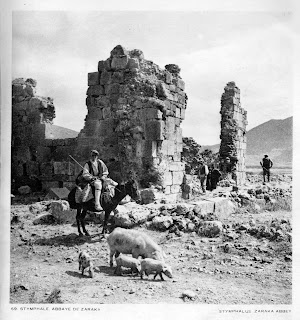For much of June, I had been obsessed with the urban archaeology of the film Dream Neighborhood (1961): June 8, June 13, June 17, and June 18. The movie also implicates the Athenian Agora excavations in one scene, where the newly renovated Stoa of Attalos creates an important background. The Stoa of Attalos was restored by the Rockefeller Foundation between 1952 and 1956. It would have been under construction during the filming of Stella, but would have been freshly completed by Dream Neighborhood.
 As I did with the funerary sequence earlier, I have sketched out a couple of scenes to help me in the framing of the filmic topography. The appearance of the Agora and the Stoa occurs when Stephania escapes the shanty town to meet her boyfriend and upper-middle-class youngsters for a spin to the suburbs. In the movie sequence she walks around Philopappou Hill and arrives at Apostolou Paulou Street, where two convertible cars wait for her. She hops on the convertible and the cars make a U-turn and spin around heading west. The figure in the middle of the street is another main character, Nekroforas carrying the lame child Themiakos, who's on his way to rob the villa of an old lady. You can see the scene here (cue 21:20 min.)
As I did with the funerary sequence earlier, I have sketched out a couple of scenes to help me in the framing of the filmic topography. The appearance of the Agora and the Stoa occurs when Stephania escapes the shanty town to meet her boyfriend and upper-middle-class youngsters for a spin to the suburbs. In the movie sequence she walks around Philopappou Hill and arrives at Apostolou Paulou Street, where two convertible cars wait for her. She hops on the convertible and the cars make a U-turn and spin around heading west. The figure in the middle of the street is another main character, Nekroforas carrying the lame child Themiakos, who's on his way to rob the villa of an old lady. You can see the scene here (cue 21:20 min.)
The characters enter a scene dominated by the Acropolis above. The image here signifies a modern Athens with automobile traffic, buses, a managed archaeological park and a beautiful setting. As the two convertibles spin around in dangerous speed, Nekroforas continues to walk towards the left. The camera zooms in and we can see more clearly his trench coat and the lame child. The camera also pans from West to East. The Acropolis disappears, while a long monument provides the visual focus. This is the Stoa of Attalos, restored by the Americans (cue 21:30 min). The long horizontal plain is mitigated by the peristyle rhythm of light and darkness. Above it rises the conic volume of Lykavittos Hill (prominent in yesterday's posting).
 Nekroforas has his back turned to the camera, so he becomes a spectator of the urban archaeology. A few paths are visible through the fenced archaeological park, as well as some installations for the archaeologists along the pavement (I can't quite tell what these are yet). At this point, a bus enters the frame from the left, which is the bus that Nekroforas will take to the suburban villa. The camera continues to pan East (to the left) following the massing of the Stoa that concludes with a view of the Thesseion (Temple of Hephaestus).
Nekroforas has his back turned to the camera, so he becomes a spectator of the urban archaeology. A few paths are visible through the fenced archaeological park, as well as some installations for the archaeologists along the pavement (I can't quite tell what these are yet). At this point, a bus enters the frame from the left, which is the bus that Nekroforas will take to the suburban villa. The camera continues to pan East (to the left) following the massing of the Stoa that concludes with a view of the Thesseion (Temple of Hephaestus).
In this scene, the ancient (Parthenon, Propylaea, Thesseion) and the modern (Stoa of Attalos restoration) are fused into one. The speed of the convertibles and the efficiency of public transportation overlap the modern construction of Athens that forms the dramatic foil to the shanty town around the corner. The Stoa of Attalos plays an important role in the dialectics of the urban story that is both temporal (ancient-modern), global (Greek-Anatolian-American) and socio-economic (dirty impoverished shanty town-clean monumental display)
REFERENCES
Leontis, Artemis. "Archaeology in the Neighborhood: Views of the Ancient Agora and Other Ruins from Outside the Gate," Journal of Modern Greek Studies 27:2, (October 2009), pp. 417-425.
Sakka, Niki. "The reconstruction of the Stoa of Attalos: Ideological and Political Aspects," Philhellenism, Philanthropy, or Political Convenience? American Archaeology in Greece," ASCSA, Athens, May 18, 2010.
Thomspon, Homer. The Stoa of Attalos II in Athens (Princeton, 1959)


